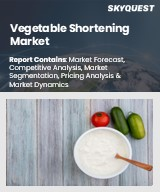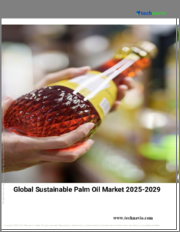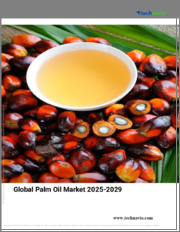
|
시장보고서
상품코드
1386030
세계의 팜핵 지방산 시장 : 등급별, 포장별, 용도별, 최종 이용 산업별, 지역별 평가, 기회 및 예측(2016-2030년)Palm Kernel Fatty Acids Market Assessment, By Grade, By Packaging, By Application, By End-use Industry, By Region, Opportunities, and Forecast, 2016-2030F |
||||||
세계 팜핵 지방산 시장 규모는 2022년 739만 톤으로 예측 기간(2023-2030년) 동안 5.7%의 CAGR로 성장하여 2030년에는 1,152만 톤에 달할 것으로 예상됩니다. 팜핵 지방산 시장의 수익 확대를 촉진하는 주요 성장 추세에는 화장품 및 퍼스널케어 제품에 유기농 소재의 적용에 대한 소비자의 인기 증가와 다양한 최종 사용 산업에서 살균 및 위생에 대한 요구가 증가하고 있는 것이 포함됩니다.
COVID-19 팬데믹, 산업 및 제조 시설의 살균 기준 강화, 가정용 세정제에 대한 소비자의 인기 증가는 세정제 보급을 촉진하는 주요 트렌드입니다. 또한, 퍼스널케어 및 화장품 산업의 성장은 R&D 활동의 증가, 화장품 제품에서 바이오 기반 성분에 대한 기업 목표의 증가, 온라인 판매 채널의 견조한 매출 등의 변수에 기인합니다. 그 결과, 세정제 사용률의 증가와 천연 성분 화장품의 채택 증가와 같은 최근 추세는 높은 라 우린 함량을 확보하기 위해 팜핵 지방산에 대한 수요를 촉진하여 시장 성장을 촉진하고 있습니다.
본 보고서는 세계의 팜핵 지방산 시장에 대해 분석했으며, 제품 개요와 시장 기본 구조, 전체 시장 규모 동향 전망, 부문별·지역별 상세 동향, 시장 배경과 주요 영향요인, 주요 기업 개요와 시장 점유율 등을 조사하여 전해드립니다.
목차
제1장 조사 방법
제2장 프로젝트 범위와 정의
제3장 주요 요약
제4장 고객의 견해
- 시장 인식과 제품 정보
- 브랜드 인지도와 로열티
- 구입 의사결정시에 고려되는 요소
- 구입 빈도
- 구입 수단
제5장 팜핵 지방산 시장 전망(2016-2030년)
- 시장 규모와 예측
- 금액 기준
- 수량 기준
- 그레이드별
- 식품 그레이드
- 산업용 그레이드
- 포장별
- 보틀
- 드럼
- 캔
- 기타
- 용도별
- 식품 및 음료용 유화제
- 화장품·퍼스널케어 성분
- 금속 가공용 윤활유·그리스
- 바이오 기반 플라스틱
- 섬유 중간체
- 세정제
- 가정용 세정제
- 산업용 세정제
- 기타
- 최종 이용 산업별
- 식품·음료
- 화장품·퍼스널케어
- 스킨케어
- 헤어케어
- 기타
- 야금
- 섬유
- 산업용
- 기타
- 지역별
- 북미
- 유럽
- 남미
- 아시아태평양
- 중동 및 아프리카
제6장 팜핵 지방산 시장 전망 : 지역별(2016-2030년)
- 북미
- 시장 규모와 예측
- 금액 기준
- 수량 기준
- 그레이드별
- 포장별
- 용도별
- 최종 이용 산업별
- 미국
- 시장 규모와 예측
- 그레이드별
- 포장별
- 용도별
- 최종 이용 산업별
- 캐나다
- 멕시코
- 시장 규모와 예측
각 부문의 정보는 대상이 되는 모든 지역 및 국가에 대해 제공됩니다.
- 유럽
- 독일
- 프랑스
- 이탈리아
- 영국
- 러시아
- 네덜란드
- 스페인
- 터키
- 폴란드
- 남미
- 브라질
- 아르헨티나
- 아시아태평양
- 인도
- 중국
- 일본
- 호주
- 베트남
- 한국
- 인도네시아
- 필리핀
- 중동 및 아프리카
- 사우디아라비아
- 아랍에미리트
- 남아프리카공화국
제7장 공급측 분석
- 생산능력 : 기업별
- 생산량 : 기업별
- 운영 효율 : 기업별
- 주요 공장 소재지(25위까지)
제8장 시장 매핑, 2022년
- 그레이드별
- 포장별
- 용도별
- 최종 이용 산업별
- 지역별
제9장 거시적 환경과 산업 구조
- 수급 분석
- 수출입 분석 - 수량과 금액
- 공급망/밸류체인 분석
- PESTEL 분석
- 정치적 요인
- 경제 시스템
- 사회적 영향
- 기술 진보
- 환경에 대한 영향
- 법령 준수와 규제 방침(법적 기관을 포함)
- Porter's Five Forces 분석
- 구매자의 교섭력
- 구매자의 교섭력
- 대체의 위협
- 신규 참여업체의 위협
- 경쟁 기업 간의 경쟁 관계
제10장 시장 역학
- 성장 원동력
- 성장 억제요인(과제, 제약)
제11장 주요 기업 상황
- 시장 리더 상위 5개사 경쟁 매트릭스
- 시장 리더 상위 5개사 시장 매출 분석(%, 2022년)
- 합병 및 인수/합작투자(해당되는 경우)
- SWOT 분석(시장 진출 기업 5개사용)
- 특허 분석(해당되는 경우)
제12장 가격 분석
제13장 사례 연구
제14장 주요 기업 전망
- KLK EMMERICH GmbH.(Kuala Lumpur Kepong Berhad)
- 기업 개요
- 주요 관리 담당자
- 제품과 서비스
- 재무 상황(보고된 대로)
- 중점 시장과 지역적 입지
- 최근의 동향
- IOI Corporation Berhad
- Wilmar International Ltd
- Oleon NV
- Oleo Misr
- Interfat SA
- TRISTAR GLOBAL
- Suriachem Sdn. Bhd.
- Caila &Pares
- Church &Dwight Co., Inc.
상기 기업은 시장 점유율에 따른 순위를 매기지 않으며, 조사 작업중에 입수 가능한 정보에 따라서 변경될 수 있습니다.
제15장 전략적 추천사항
제16장 조사 회사와 면책사항
ksm 23.12.07Global Palm Kernel Fatty Acids Market size was recorded at 7.39 million tons in 2022, which is expected to grow to 11.52 million tons in 2030 with a CAGR of 5.7% during the forecast period between 2023 and 2030. The prime growth trends boosting the revenue expansion of the palm kernel fatty acid market include increasing sanitization & hygiene needs from various end-use industries along with rising consumer preference towards organic materials deployment in cosmetics & personal care products.
The advent of the COVID-19 pandemic, increasing sanitization norms in industrial manufacturing facilities, and the rising consumer inclination towards home cleaning products are the key trends driving the adoption of cleaning products. Also, the growth of the personal care & cosmetics industry is attributed to variables such as increasing research & development activities, rising company targets for bio-based ingredients in cosmetics products, and robust sales from the online sales channel. As a result, recent trends such as the rising utilization of cleaning products and increasing adoption of natural ingredient cosmetics are fostering the demand for palm kernel fatty acid to ensure high Lauric content is propelling the market growth.
Increasing Adoption of Palm Kernel Fatty Acids in Cleaning Products Supplements Market Growth
Palm kernel fatty acid has superior cleaning agent properties. As a result, palm kernel fatty acid is ideal for cleaning products such as detergents, soaps, and surfactants to boost the foam. The changing lifestyle habits of people coupled with the rapid pace of urbanization is increasing awareness related to hygiene & sanitization products, which, in turn, is spurring the demand for cleaning products.
For illustration, according to the recent statistics published by the International Association for Soaps, Detergents and Maintenance Products (A.I.S.E.), in 2022, the European home cleaning products industry was valued at USD 35.9 billion (Euro 34.1 billion), representing a year-on-year growth rate of 5.2%. Likewise, the industrial cleaning sector in Europe was valued at USD 9.2 billion (EURO 8.7 billion), an annual growth rate of 19.1% in 2022. Henceforth, the rise in the production of cleaning products is fueling the demand for palm kernel fatty acid since it is a key ingredient in household and industrial cleaning products, this, in turn, is amplifying the market growth.
The Rise in the Deployment of Palm Kernel Fatty Acids in Cosmetics & Personal Care Products is Spurring the Market
The key benefits associated with palm kernel fatty acids include protection against harmful UV rays and enhanced vitamin E content in the skin. Thus, palm kernel fatty acid is ideal for cosmetics & personal care products such as shampoo, creams, and lotions for wrinkles & fine lines. The increasing demand for long-lasting skin hydrating creams, along with the rising regulations for toxic additives elimination in skincare products, are the prominent aspects driving the cosmetics & personal care industry growth.
For instance, as of October 2023, L'Oreal S.A., a leading manufacturer of cosmetics & personal care products, employs palm kernel oil derivatives, including palm kernel fatty acids in products such as shampoo and skincare products. Hence, the increase in the deployment of palm kernel fatty acids in cosmetics & personal care products to ensure superior cleaning impact for the skin is a prime element augmenting the market growth.
Asia-Pacific held the Dominant Share in the Palm Kernel Fatty Acid Market
The presence of prominent market players headquartered in the Asia-Pacific countries such as Malaysia, Thailand and India, the prospering investment opportunities in various end-use industries, the rise in the production of cleaning products, and the increase in the shift from chemical-based products to bio-based products are several major determinants proliferating the palm kernel fatty acid market growth.
For instance, according to the Chemicals and Petrochemicals Manufacturers' Association (CPMA), in 2021-22, the production of synthetic detergent intermediates was 780 thousand tons, an increase of 6.0% compared to 2021. Therefore, the rise in the production of cleaning products in the Asia-Pacific region is fostering the demand for palm kernel fatty acid to ensure adequate cleaning functionality, thereby driving the market growth.
Future Outlook Scenario
The increasing adoption of long-term sustainability targets in the metallurgy and chemical industry will boost the adoption of palm kernel fatty acids. For instance, BASF SE is targeting to increase the voluntary commitment to sustainable procurement of primary, intermediate products based on palm kernel oil and palm oil by 2025. Hence, the increasing sustainability norms will accelerate the adoption of palm kernel oil derivatives, including palm kernel fatty acids, this, in turn, will create a lucrative growth opportunity for the market in the upcoming years.
Robust demand growth for personal & hygiene products and the development of new manufacturing facilities will propel the demand for personal hygiene products in the long run. For instance, according to Invest India, an Indian government nodal agency, in 2022, the Indian personal care and hygiene industry was valued at USD 15.05 billion. It will reach USD 17.34 billion by 2026, representing a growth rate of 15.21%. Hence, the future anticipated revenue expansion of the personal care and hygiene sector will create a prominent palm kernel fatty acids growth outlook during the projected forecast period.
The recent investments in the food & beverage emulsifier manufacturing facilities will drive the adoption of palm kernel fatty acids in the future, thereby creating a vital potential for market growth. For instance, in June 2020, Palsgaard, a food emulsifier manufacturer in Denmark, invested USD 114.2 million (EURO 100 million) to double the production capacity of emulsifiers in Denmark by 2024.
Key Players Landscape and Outlook
The major players in the palm kernel fatty acids market are: KLK EMMERICH GmbH. (Kuala Lumpur Kepong Berhad), IOI Corporation Berhad, Wilmar International Ltd, and Oleon NV. The above players involved in the manufacturing & supply of palm kernel fatty acids are investing in strategies, including technology innovation, acquisitions, product innovations, and facility development to increase their market revenue & volume share in the palm kernel fatty acids industry.
For instance, in April 2023, KLK EMMERICH GmbH. acquired Temix Oleo SpA, an Italy-based manufacturer of fatty acids sourced from renewable sources. The prime focus of the acquisition was to increase the overall market share of KLK EMMERICH GmbH in the palm kernel fatty acids industry.
Table of Contents
1. Research Methodology
2. Project Scope & Definitions
3. Executive Summary
4. Voice of Customer
- 4.1. Market Awareness and Product Information
- 4.2. Brand Awareness and Loyalty
- 4.3. Factors Considered in Purchase Decision
- 4.3.1. Brand Name
- 4.3.2. Quality
- 4.3.3. Quantity
- 4.3.4. Price
- 4.3.5. Product Specification
- 4.3.6. Application Specification
- 4.3.7. VOC/Toxicity Content
- 4.3.8. Availability of Product
- 4.4. Frequency of Purchase
- 4.5. Medium of Purchase
5. Palm Kernel Fatty Acids Market Outlook, 2016-2030F
- 5.1. Market Size & Forecast
- 5.1.1. By Value
- 5.1.2. By Volume
- 5.2. By Grade
- 5.2.1. Food Grade
- 5.2.2. Industrial Grade
- 5.3. By Packaging
- 5.3.1. Bottles
- 5.3.2. Drums
- 5.3.3. Cans
- 5.3.4. Others
- 5.4. By Application
- 5.4.1. Food & Beverage Emulsifier
- 5.4.2. Cosmetics & Personal Care Ingredients
- 5.4.3. Metal Working Lubricants & Greases
- 5.4.4. Bio-based Plastic
- 5.4.5. Textile Intermediates
- 5.4.6. Cleaning Products
- 5.4.6.1. Household Cleaning Products
- 5.4.6.2. Industrial Cleaning Products
- 5.4.7. Others
- 5.5. By End-use Industry
- 5.5.1. Food & Beverage
- 5.5.2. Cosmetics & Personal Care
- 5.5.2.1. Skincare
- 5.5.2.2. Haircare
- 5.5.2.3. Others
- 5.5.3. Metallurgy
- 5.5.4. Textile
- 5.5.5. Industrial
- 5.5.6. Others
- 5.6. By Region
- 5.6.1. North America
- 5.6.2. Europe
- 5.6.3. South America
- 5.6.4. Asia-Pacific
- 5.6.5. Middle East and Africa
6. Palm Kernel Fatty Acids Market Outlook, By Region, 2016-2030F
- 6.1. North America*
- 6.1.1. Market Size & Forecast
- 6.1.1.1. By Value
- 6.1.1.2. By Volume
- 6.1.2. By Grade
- 6.1.2.1. Food Grade
- 6.1.2.2. Industrial Grade
- 6.1.3. By Packaging
- 6.1.3.1. Bottles
- 6.1.3.2. Drums
- 6.1.3.3. Cans
- 6.1.3.4. Others
- 6.1.4. By Application
- 6.1.4.1. Food & Beverage Emulsifier
- 6.1.4.2. Cosmetics & Personal Care Ingredients
- 6.1.4.3. Metal Working Lubricants & Greases
- 6.1.4.4. Bio-based Plastic
- 6.1.4.5. Textile Intermediates
- 6.1.4.6. Cleaning Products
- 6.1.4.6.1. Household Cleaning Products
- 6.1.4.6.2. Industrial Cleaning Products
- 6.1.4.7. Others
- 6.1.5. By End-use Industry
- 6.1.5.1. Food & Beverage
- 6.1.5.2. Cosmetics & Personal Care
- 6.1.5.2.1. Skincare
- 6.1.5.2.2. Haircare
- 6.1.5.2.3. Others
- 6.1.5.3. Metallurgy
- 6.1.5.4. Textile
- 6.1.5.5. Industrial
- 6.1.5.6. Others
- 6.1.6. United States*
- 6.1.6.1. Market Size & Forecast
- 6.1.6.1.1. By Value
- 6.1.6.1.2. By Volume
- 6.1.6.2. By Grade
- 6.1.6.2.1. Food Grade
- 6.1.6.2.2. Industrial Grade
- 6.1.6.3. By Packaging
- 6.1.6.3.1. Bottles
- 6.1.6.3.2. Drums
- 6.1.6.3.3. Cans
- 6.1.6.3.4. Others
- 6.1.6.4. By Application
- 6.1.6.4.1. Food & Beverage Emulsifier
- 6.1.6.4.2. Cosmetics & Personal Care Ingredients
- 6.1.6.4.3. Metal Working Lubricants & Greases
- 6.1.6.4.4. Bio-based Plastic
- 6.1.6.4.5. Textile Intermediates
- 6.1.6.4.6. Cleaning Products
- 6.1.6.4.6.1. Household Cleaning Products
- 6.1.6.4.6.2. Industrial Cleaning Products
- 6.1.6.4.7. Others
- 6.1.6.5. By End-use Industry
- 6.1.6.5.1. Food & Beverage
- 6.1.6.5.2. Cosmetics & Personal Care
- 6.1.6.5.2.1. Skincare
- 6.1.6.5.2.2. Haircare
- 6.1.6.5.2.3. Others
- 6.1.6.5.3. Metallurgy
- 6.1.6.5.4. Textile
- 6.1.6.5.5. Industrial
- 6.1.6.5.6. Others
- 6.1.7. Canada
- 6.1.8. Mexico
- 6.1.1. Market Size & Forecast
All segments will be provided for all regions and countries covered:
- 6.2. Europe
- 6.2.1. Germany
- 6.2.2. France
- 6.2.3. Italy
- 6.2.4. United Kingdom
- 6.2.5. Russia
- 6.2.6. Netherlands
- 6.2.7. Spain
- 6.2.8. Turkey
- 6.2.9. Poland
- 6.3. South America
- 6.3.1. Brazil
- 6.3.2. Argentina
- 6.4. Asia-Pacific
- 6.4.1. India
- 6.4.2. China
- 6.4.3. Japan
- 6.4.4. Australia
- 6.4.5. Vietnam
- 6.4.6. South Korea
- 6.4.7. Indonesia
- 6.4.8. Philippines
- 6.5. Middle East & Africa
- 6.5.1. Saudi Arabia
- 6.5.2. UAE
- 6.5.3. South Africa
7. Supply Side Analysis
- 7.1. Capacity, By Company
- 7.2. Production, By Company
- 7.3. Operating Efficiency, By Company
- 7.4. Key Plant Locations (Up to 25)
8. Market Mapping, 2022
- 8.1. By Grade
- 8.2. By Packaging
- 8.3. By Application
- 8.4. By End-use Industry
- 8.5. By Region
9. Macro Environment and Industry Structure
- 9.1. Supply Demand Analysis
- 9.2. Import Export Analysis - Volume and Value
- 9.3. Supply/Value Chain Analysis
- 9.4. PESTEL Analysis
- 9.4.1. Political Factors
- 9.4.2. Economic System
- 9.4.3. Social Implications
- 9.4.4. Technological Advancements
- 9.4.5. Environmental Impacts
- 9.4.6. Legal Compliances and Regulatory Policies (Statutory Bodies Included)
- 9.5. Porter's Five Forces Analysis
- 9.5.1. Supplier Power
- 9.5.2. Buyer Power
- 9.5.3. Substitution Threat
- 9.5.4. Threat from New Entrant
- 9.5.5. Competitive Rivalry
10. Market Dynamics
- 10.1. Growth Drivers
- 10.2. Growth Inhibitors (Challenges, Restraints)
11. Key Players Landscape
- 11.1. Competition Matrix of Top Five Market Leaders
- 11.2. Market Revenue Analysis of Top Five Market Leaders (in %, 2022)
- 11.3. Mergers and Acquisitions/Joint Ventures (If Applicable)
- 11.4. SWOT Analysis (For Five Market Players)
- 11.5. Patent Analysis (If Applicable)
12. Pricing Analysis
13. Case Studies
14. Key Players Outlook
- 14.1. KLK EMMERICH GmbH. (Kuala Lumpur Kepong Berhad)
- 14.1.1. Company Details
- 14.1.2. Key Management Personnel
- 14.1.3. Products & Services
- 14.1.4. Financials (As reported)
- 14.1.5. Key Market Focus & Geographical Presence
- 14.1.6. Recent Developments
- 14.2. IOI Corporation Berhad
- 14.3. Wilmar International Ltd
- 14.4. Oleon NV
- 14.5. Oleo Misr
- 14.6. Interfat SA
- 14.7. TRISTAR GLOBAL
- 14.8. Suriachem Sdn. Bhd.
- 14.9. Caila & Pares
- 14.10. Church & Dwight Co., Inc.
Companies mentioned above DO NOT hold any order as per market share and can be changed as per information available during research work.



















